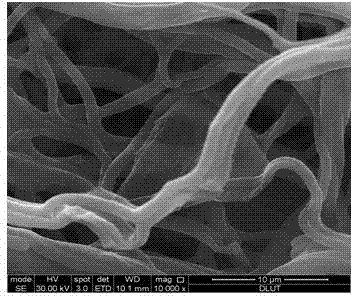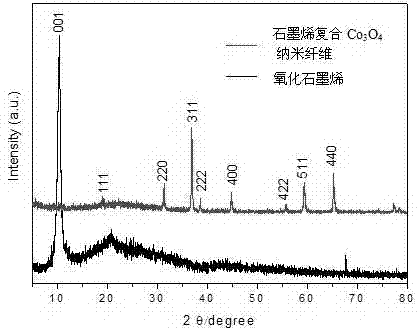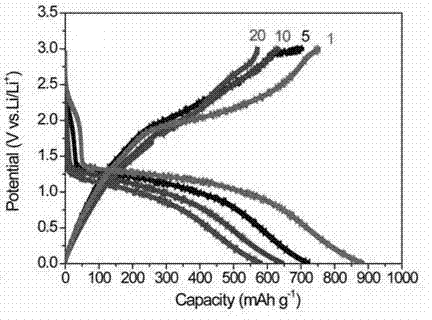Graphene composite transition metal oxide nanofiber lithium ion battery electrode material and preparation method thereof
A graphene composite and lithium-ion battery technology, applied in the direction of battery electrodes, nanotechnology, nanotechnology, etc., can solve the problems of weak bonding, poor long-term cycle stability, and easy to fall off, so as to improve cycle stability and effective Facilitate intercalation and extraction, and improve the effect of lithium intercalation capacity
- Summary
- Abstract
- Description
- Claims
- Application Information
AI Technical Summary
Problems solved by technology
Method used
Image
Examples
Embodiment 1
[0032] 1) Preparation of isocyanate-modified graphene oxide dispersion
[0033]Disperse 0.1 mg or 0.5 mg or 1 mg or 4 mg or 6 mg or 8 mg or 10mg of graphene oxide (0.1-10mg can be) into 1mL or 2mL or 4mL or 6mL or 8mL or 10mL (1-10mL can be ) in dimethylformamide or dimethylacetamide or tetrahydrofuran or dichloromethane or dichloroethane or acetone or ethanol solvent, magnetic stirring for 1h or 1.5h or 2h (1 h -2 h is acceptable), and then Ultrasonic dispersion for 30 minutes or 40 minutes or 50 minutes or 60 minutes (30-60 minutes can be used). The temperature rises to 30°C or 35°C or 40°C (30°C-40°C is acceptable), and then under the protection of nitrogen, add 0.1 mg or 0.2 mg or 0.4 mg or 0.6 mg or 0.8 mg or 1 mg (0.1 mg -1 mg can be) methyl isocyanate or toluene diisocyanate or diphenylmethane diisocyanate or dicyclohexylmethane diisocyanate, stirred for 24h or 30h or 48h (in 24h -48h can be), to obtain isocyanate modified oxidation Graphene dispersion.
[0034] In t...
Embodiment 2
[0043] 1) Disperse 5 mg of graphene oxide into 10 mL of dimethylformamide solvent, stir magnetically for 1 h, and disperse ultrasonically for 60 min. The temperature was raised to 30° C., and then under the protection of nitrogen, 0.1 mg of isocyanate was added and stirred for 24 hours to obtain an isocyanate-modified graphene oxide dispersion.
[0044] 2) Dissolve 0.1 g of manganese acetate in 10 mL of isocyanate-modified graphene oxide dispersion, and stir at room temperature for 1 h. Then, 1.67 g of polystyrene was added to the above solution, and a mixed solution with a concentration of 15% (wt) was prepared, and magnetically stirred for 3 hours until a uniform, stable, and viscous solution was formed.
[0045] 3) Inhale the solution in step 2) into a 10ml glass syringe equipped with a 9# stainless steel needle, the receiving device uses flat aluminum foil, and the distance from the stainless steel needle tip to the receiving device is 15cm. The stainless steel needle is ...
Embodiment 3
[0048] 1) Disperse 5 mg of graphene oxide into 10 mL of dimethylformamide solvent, stir magnetically for 1 h, and disperse ultrasonically for 60 min. The temperature was raised to 30° C., and then under the protection of nitrogen, 0.1 mg of isocyanate was added and stirred for 24 hours to obtain an isocyanate-modified graphene oxide dispersion.
[0049] 2) Weigh 2 ml of butyl titanate and dissolve in 10 ml of isocyanate-modified graphene oxide dispersion, and stir at room temperature for 1 h. Then add 0.3 g of polyacrylonitrile to the above solution, configure a mixed solution with a concentration of 10% (wt), and stir it magnetically for 3 hours until a uniform, stable and viscous solution is formed.
[0050] 3) Inhale the solution in step 2) into a 10ml glass syringe equipped with a 9# stainless steel needle. The receiving device is made of flat aluminum foil, and the distance from the tip of the stainless steel needle to the receiving device is 20cm. The stainless steel ne...
PUM
| Property | Measurement | Unit |
|---|---|---|
| thickness | aaaaa | aaaaa |
| diameter | aaaaa | aaaaa |
| diameter | aaaaa | aaaaa |
Abstract
Description
Claims
Application Information
 Login to View More
Login to View More - R&D
- Intellectual Property
- Life Sciences
- Materials
- Tech Scout
- Unparalleled Data Quality
- Higher Quality Content
- 60% Fewer Hallucinations
Browse by: Latest US Patents, China's latest patents, Technical Efficacy Thesaurus, Application Domain, Technology Topic, Popular Technical Reports.
© 2025 PatSnap. All rights reserved.Legal|Privacy policy|Modern Slavery Act Transparency Statement|Sitemap|About US| Contact US: help@patsnap.com



